Master the Basics: A Guide to Effective Pickleball Drills.
Pickleball has taken the sporting world by storm, appealing to people of all ages and skill levels. As a blend of tennis, badminton, and ping-pong, the sport emphasizes strategy, agility, and technique, making it essential for players to engage in drills and practice routines that enhance their skills. Whether you’re a beginner learning the fundamentals or an advanced player aiming for competitive excellence, incorporating the right drills can profoundly impact your performance. In this comprehensive guide, we will explore various pickleball drills, categorized by skill level, to help you develop your abilities on the court.
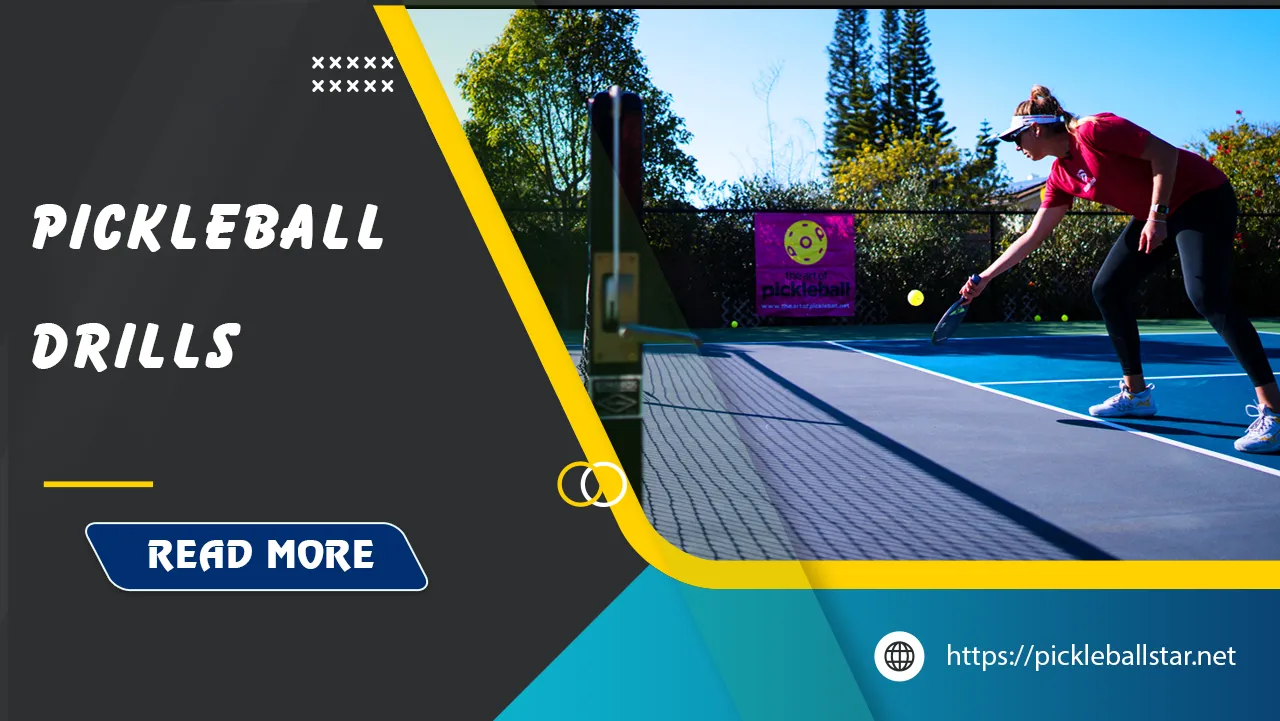
From basic fundamentals like groundstrokes and dinking to advanced techniques such as spin shots and reaction time drills, each section will delve into specific exercises designed to sharpen your skills. Practicing alone or with partners, these drills can help you build confidence, improve consistency, and cultivate strategic gameplay. Let’s dive into the world of pickleball drills and discover how to elevate your game.
Beginner Drills
Beginner drills focus on essential skills that lay the groundwork for more complex techniques. As a new player, you should prioritize mastering basic forehand and backhand groundstrokes, dinking, serving, court awareness, and volleying. These skills serve as the cornerstone upon which you can build your future pickleball expertise.
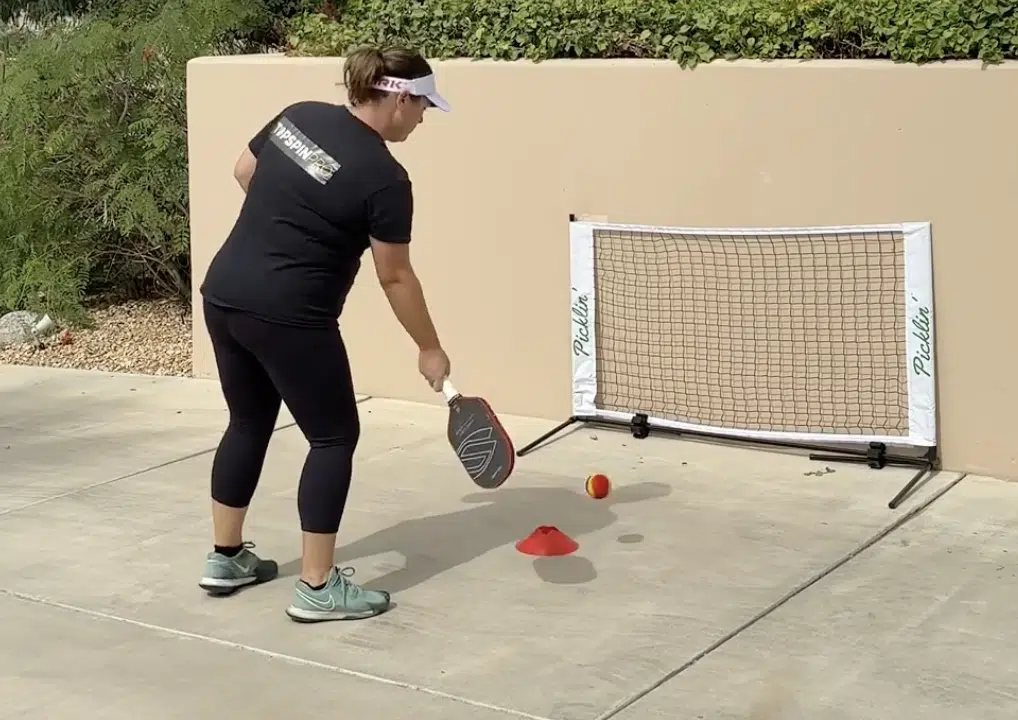
Basic Forehand and Backhand Groundstrokes
To develop consistency in your game, it’s vital to practice forehand and backhand groundstrokes regularly.
- Understanding the Forehand Groundstroke:
- Position yourself in the ready stance. Pivot your shoulders and hips towards the incoming ball, creating a balanced base.
- As the ball approaches, step forward with your front foot and swing your paddle smoothly forward, ensuring the ball makes contact in front of your body.
- Follow through, allowing the paddle to move towards your target while returning to the ready position.
- Understanding the Backhand Groundstroke:
- Similar to forehands, position yourself appropriately to react to the incoming ball.
- Pivot your hips and rotate your shoulders to face the ball, stepping forward with your front foot.
- Focus on making contact in front of your body, and don’t forget to follow through this is critical for both accuracy and power.
- Drill Idea – Wall Drills:
- Find a flat wall and draw a target outline (around 34 inches high). Practice hitting against the wall using both forehand and backhand strokes, aiming for your target.
- As you improve, increase the distance from the wall or vary the height of your targets, which will help enhance your control and consistency.
Dink Shot Practice
Dinking is a foundational skill in pickleball that involves soft shots aimed just over the net, particularly beneficial in strategic gameplay.
- Dinking in the Kitchen:
- Pair up with a partner and stand at the kitchen line. Focus on hitting soft shots back and forth, keeping the ball in the kitchen and avoiding volleys.
- Concentrate on controlling the ball height and precision to master this critical shot.
- Cross-Court Dinks:
- Stand diagonally across from your partner, aiming to hit cross-court shots that land in the non-volley zone.
- This variation challenges your accuracy and allows you to practice different angles in your shots.
- Backhand and Forehand Dinks:
- Alternate between practicing forehand and backhand dinks with your partner. This ensures both dinking styles are cultivated equally and prepares you for various scenarios on the court.
- Half-Court Dinking:
- Play the drill on just half the court. One player stands on one side and focuses on dinking the ball back without worrying about full-court movement.
- This allows you to concentrate solely on dinking technique and rhythm to build your touch.
Serving Techniques
Developing your serving technique is crucial, as it initiates every point in a match.
- Basic Serve Practice:
- Start serving from the baseline, focusing on accurate placement. Use targets like cones or lines on the court to develop depth in your serves.
- Alternate between underhand and overhand serves, familiarizing yourself with different angles and strategies.
- Two-Bounce Drill:
- This involves serving so that the ball bounces twice on your opponent’s side before they can return it.
- Focus on developing depth and power while practicing from various locations on the court.
- Target Serving:
- Set up targets (like hula hoops) on the court and aim to land your serves inside these areas.
- This drill will help cultivate precision and control, which are essential for competitive play.
Court Awareness Drills
Understanding the dynamics of court positioning is essential for maintaining a strategic edge during gameplay.
- Court Positioning Drill:
- Engage in a doubles match while emphasizing proper positioning. Ensure you and your partner communicate effectively about coverage roles.
- Implement strategies for shifting positions based on ball dynamics, enabling you to maintain a strong formation.
- Moving with the Ball:
- Practice with a partner, and emphasize positioning yourself in response to where the ball is hit, enhancing your spatial awareness.
- Set scenarios where one player hits the ball to various court areas, allowing you opportunities to reposition effectively.
- Simulated Game Scenarios:
- Set drills to simulate real match situations, challenging yourself with different playing conditions.
- This exercise develops reaction times and decision-making abilities under pressure, both vital in actual play.
Volleying Basics
Volleying requires fast reactions and precise techniques, making it essential to practice these skills early on.
- Volley-to-Volley Drill:
- Stand on opposite sides of the net and continue to hit the ball back and forth without letting it bounce. This drill emphasizes timing and control.
- As you become more comfortable, increase the speed of your exchanges.
- Kitchen Line Drills:
- Practice volleying back and forth with a partner while standing at the kitchen line.
- Focus on hitting the ball above the net without letting it bounce to solidify your volleying techniques.
- Targeting with Volleys:
- Set up cones or targets on the court where you aim to volley the ball. This helps improve both placement and accuracy.
By regularly practicing these beginner drills, new players will build a strong foundation in essential pickleball skills, including groundstrokes, dinking, serving, court awareness, and volleying. Building these essential techniques will significantly enhance overall performance on the court, leading to greater confidence and success during competitive play.
Intermediate Drills
Once you have mastered the basics, moving to intermediate drills will help refine your skills and prepare you for more challenging gameplay. These drills focus on groundstroke consistency, alternate hitting, half-volley techniques, serve and return strategies, and basic footwork and agility drills.
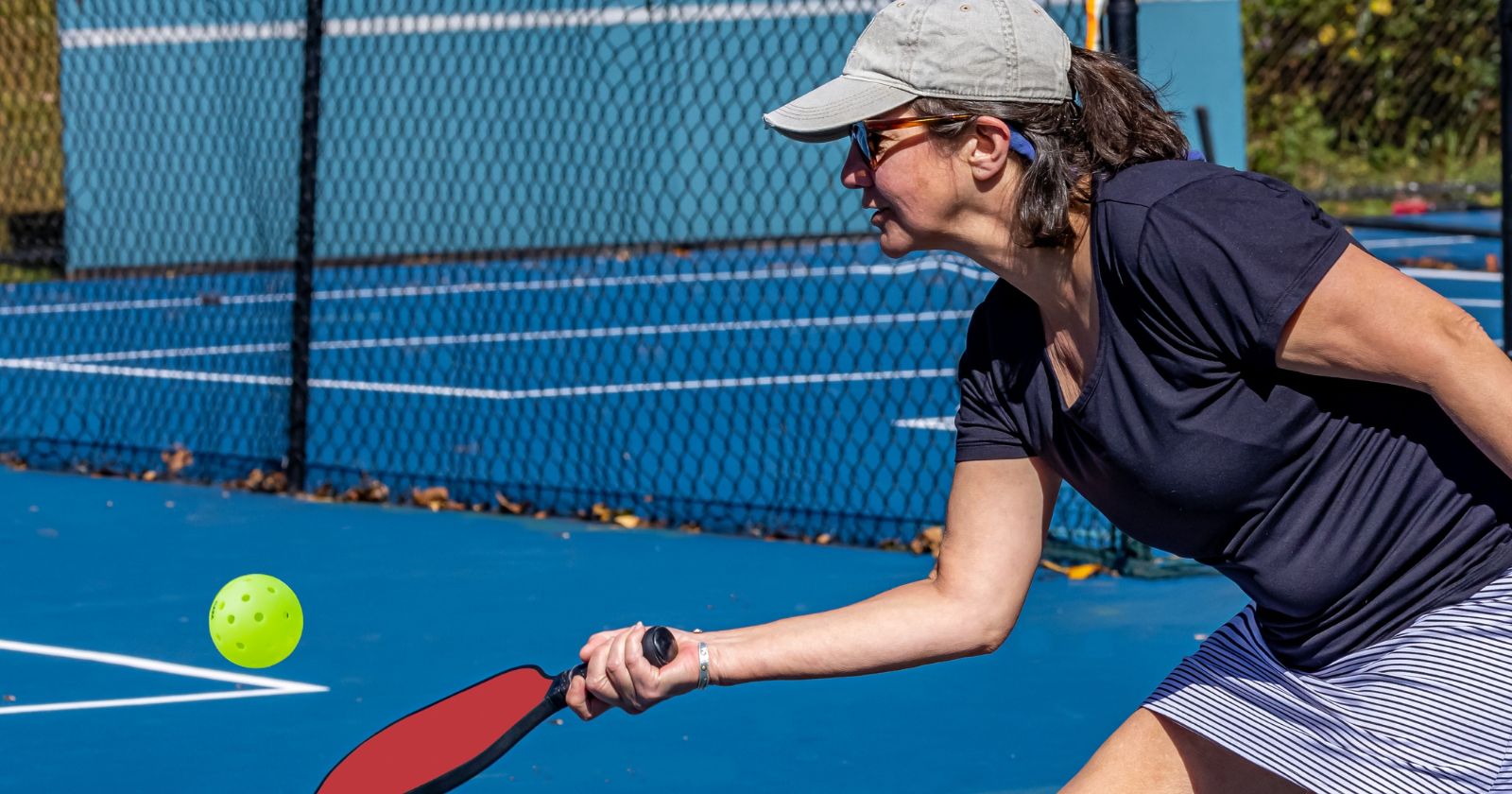
Groundstroke Consistency Drills
To improve your groundstroke consistency as an intermediate player, consider the following drills:
- Basic Groundstroke Drill:
- Target consistency by completing a set number of forehand (e.g., 10) and backhand strokes without missing.
- Maintain control during your shots and strive to hit the ball over the net repeatedly.
- Alternating Forehand and Backhand Drill:
- This drill emphasizes quick transitions between strokes, reinforcing coordination and rhythm.
- Partner up and hit alternating strokes (forehands to forehand, backhands to backhand) while focusing on placement and timing.
- Cross-Court Groundstroke Drill:
- Facing each other on opposite sides, focus on hitting alternating forehands and backhands cross-court.
- Emphasize targeted depth and the use of body rotation to develop controlled consistency.
- Conditioned Game Drill:
- Play points focusing only on alternating strokes, helping you improve both technique and mental focus under pressure.
- By keeping the score, this drill simulates game scenarios and encourages tactical thinking.
- Target Practice Drill:
- Set targets to hit with your groundstrokes while alternating between forehand and backhand strokes.
- This not only builds precision but also fosters the ability to aim for specific locations during matches.
Alternate Hits Between Forehand and Backhand
- Alternating Hits Warm-Up:
- Start with a light session where you and your partner alternate between forehand and backhand strokes.
- This helps establish a rhythm and warms you up for more focused drills.
- Drill for Precision:
- Hit a ball to your partner while they alternate backhand and forehand shots. Challenge them to keep the rally going while focusing on accuracy.
- Game-like Situations:
- Create scenarios where each player must alternate shots in tailored drills.
- This promotes adaptability and prepares players for actual match conditions.
Short Hop and Half-Volley Techniques
- Short Hop Drill:
- Stand close to a wall and focus on hitting the ball right after it bounces (half-volley).
- This helps develop timing and the ability to relocate the ball with precision.
- Speed and Control Variation:
- As you improve, increase the pace of your half-volley shots to simulate match situations.
Serve and Return Strategies
- Serving Practice:
- Focus on various serve placements and spins, establishing depth and angles in your serves.
- Use targets on the opposite side to improve accuracy.
- Return of Serve Drill:
- Evaluate effective return practices against various serves.
- Include drills that work on quick foot placement and creating opportunities to attack immediately after the return.
Basic Footwork and Agility Drills
- Equality Movement Drill:
- Set markers for quick direction changes and lateral shuffles.
- Normalize these movements to enhance agility on the court.
- Footwork with the Ball:
- Engage in exercises focused on precise foot placement while executing shots at the same time.
- This builds a solid foundation for executing advanced footwork techniques.
Incorporating these intermediate drills into your weekly practice will take your pickleball skills to the next level. Focusing on consistency with groundstrokes, refining serve and return strategies, and honing footwork will allow you to become a more competitive player on the court.
Advanced Drills
For advanced players seeking to refine their skills and elevate their game, specialized drills that focus on spin, reaction time, game simulation, targeted shots, and aggressive footwork are crucial. These drills require a greater understanding of technique and strategy, as they prepare players for competitive play.
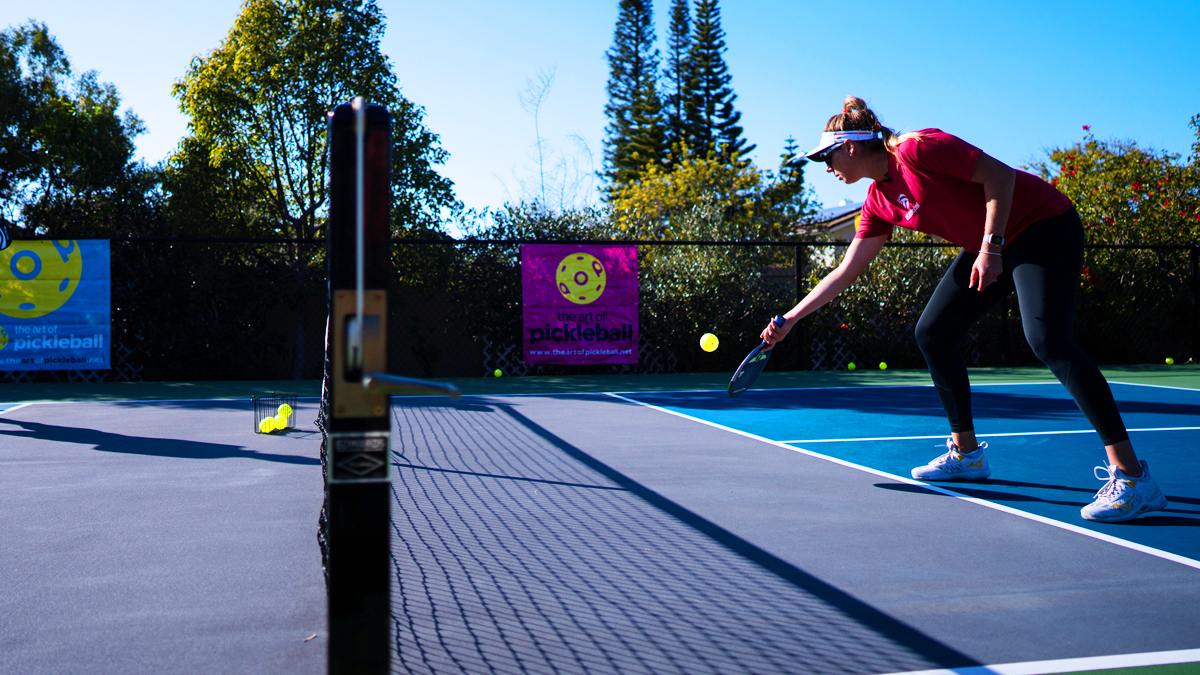
Spin and Slice Variations
- Solo Wall Practice for Spin:
- Stand at a distance from a wall and practice hitting forehands and backhands with a focus on spin. Experiment with topspin, backspin, and side spin shots.
- This drill helps develop control and familiarity with generating spin.
- Forehand and Backhand Slice Drill:
- Alternate practicing forehand and backhand slices, emphasizing the paddle angle to create maximum spin.
- Focus on using different slices based on the incoming shots for varied gameplay.
- Targeted Spin Shots:
- Set up specific targets on the court, focusing on hitting with spin. This increases your ability to control the ball while adding a strategic layer to your game.
Reaction Time and Speed Control Drills
- Hit and Sprint Drill:
- Start at the baseline, hit a ball to a predetermined location, and then sprint to the opposite side to return the ball.
- This exercise emphasizes quick reactions and helps improve speed and court coverage.
- High-speed Volleys:
- Engage in rapid volley drills with a partner, alternating returns. Focus on maintaining control while increasing rally speeds to enhance reflexes.
- The Side Swipe Drill:
- Incorporate quick movements from side to side while hitting the ball, enhancing your agility and reaction time.
Game Simulation Drills
- Skinny Singles:
- Play singles using a narrow court format to work on your shot placements and accuracy under restricted conditions.
- This helps improve tactical decision-making and mixed shot preparation.
- Two-on-One Drill:
- In this setup, one player faces two opponents. The single player focuses on defending while the two work on placing pressure.
- This builds both individual defensive skills and the ability to read opponents.
Targeted Shot Practice
- Serve Accuracy Drill:
- Practice serves aimed at specific target areas to sharpen your consistency and deepen your serve knowledge.
- Work on varying spin and angle for serves.
- Blocking and Counter Shot Drill:
- Practice rallying with a partner while focusing on quick, responsive shots from strategic locations.
- This drill teaches you how to counter your opponents effectively.
High-Intensity Footwork Drills
- Reflex Training:
- Pair up to practice receiving balls hit at you, focusing on quick reactions and adjusting your stance to set shots.
- This builds essential coordination having quick return strikes.
- Cardio and Agility Training:
- Incorporate circuit-based training or interval sprinting drills that develop overall fitness, agility, and speed, which are crucial for matchplay.
By integrating these advanced drills into your practice routine, you’ll enhance your competitive gameplay and master advanced techniques and skills. Focusing on developing spins, honing your reaction time, and effective shot placements will empower you on the court.
Drills for Improving Court Strategy
A significant aspect of playing pickleball involves implementing effective court strategies. The following drills will help you master partner positioning, communication, and adaptability, all while analyzing your opponent’s play.
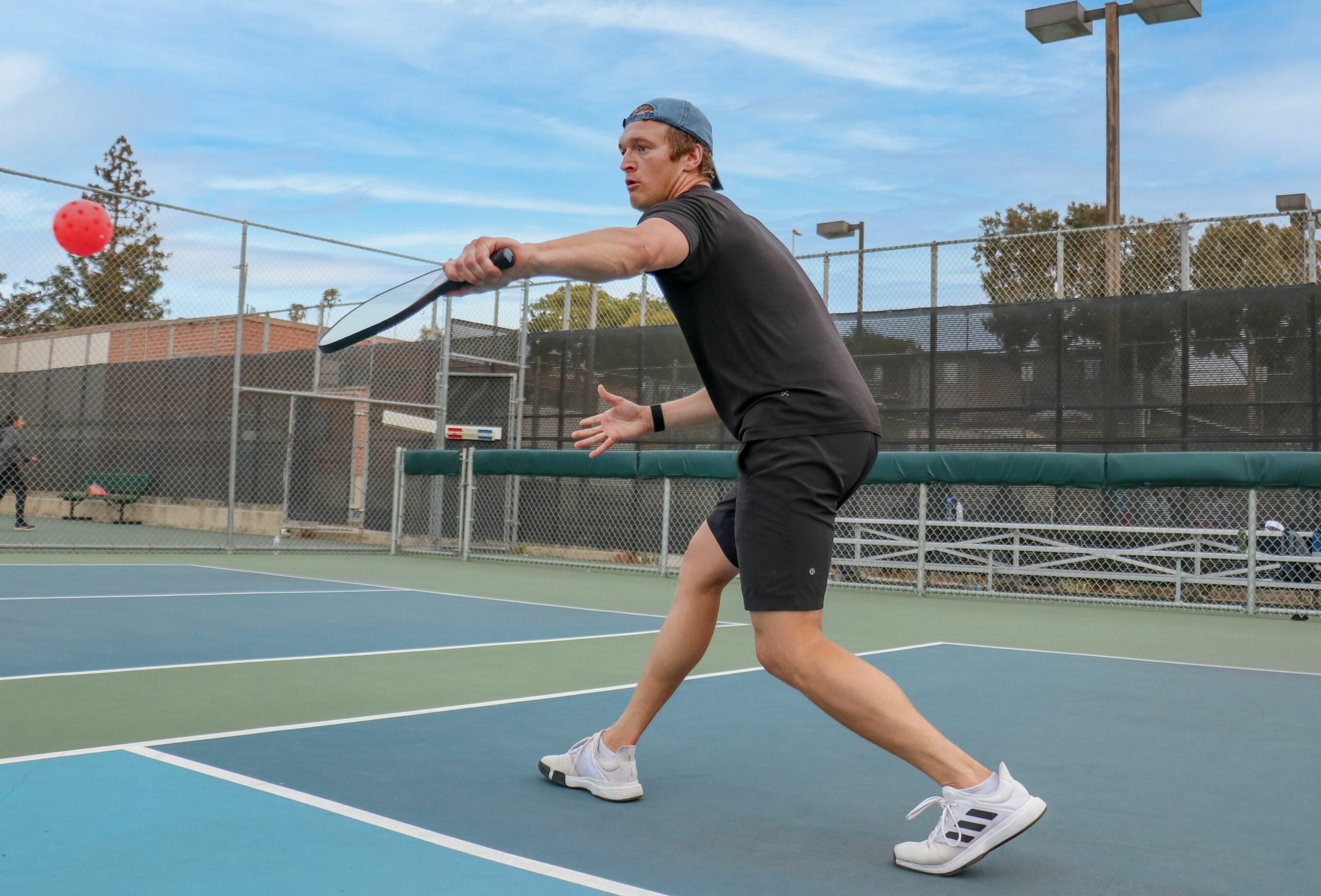
Partner Positioning and Communication Exercises
- Court Coverage Drill:
- Teams of two should work on maintaining optimal positioning while playing matches.
- This helps you learn how to effectively cover the court and communicate with partners.
- Stacking Positioning Drill:
- Focus on serving and transitioning into a stacking position. Ensure both partners understand their roles in this formation.
- Partner Communication Drill:
- Designate verbal cues for shot ownership. Emphasizing communication enhances knowledge of when to attack or defend.
Offensive and Defensive Shot Sequences
- Third Shot Drop Drill:
- One player practices the serve while the other focuses on executing effective third-shot drops, landing in the opponent’s non-volley zone.
- Repeat this drill to master touch and placement for the third shot.
- Defensive Positioning Drill:
- Work on shifting dynamically based on the shots from your opponent.
- Emphasize quick decision-making during point dynamics to reinforce strategic responses.
Analyzing Opponent’s Patterns
- Observational Drills:
- During practice matches, take notes on your opponents’ tendencies and adjustments during play.
- Discuss these observations with your partner after play to enhance tactical awareness.
- Descriptive Movement Routine:
- Partner up, and each player must describe their movement for the rally.
- This encourages discussion about shot selection and reaction time.
Adaptive Play Strategy Drills
- What-If Scenarios:
- Create scenarios where you predict opponents’ weaknesses based on observed patterns.
- Practicing counter-strategies empowers you to adapt flexibility during matches.
- Transitioning Strategies:
- Focus on moving from offensive to defensive play, simulating real match dynamics.
- Engage in drills that require players to reposition based on incoming shots.
Awareness and Anticipation Techniques
- Tracking Movement Drill:
- Have one partner alternate between shots as the other tracks their movement.
- This builds awareness of opponent’s tendencies and reaction time.
- Mindfulness Practice:
- Incorporate mindfulness techniques to improve concentration during games.
- Practicing being present enhances decision-making and anticipation.
By committing to these court strategy drills, you will elevate your pickleball gameplay significantly. Mastering communication, positioning, and adaptability will give you an advantage over your opponents, enhancing your performance during matches.
Specialized Drills
In pickleball, specialized drills can help refine specific shot techniques and overall gameplay strategies. This section will cover drills focusing on dinks and drop shots, overhead smash practice, lobbing techniques, recovery and movement drills, and competitive play variations.
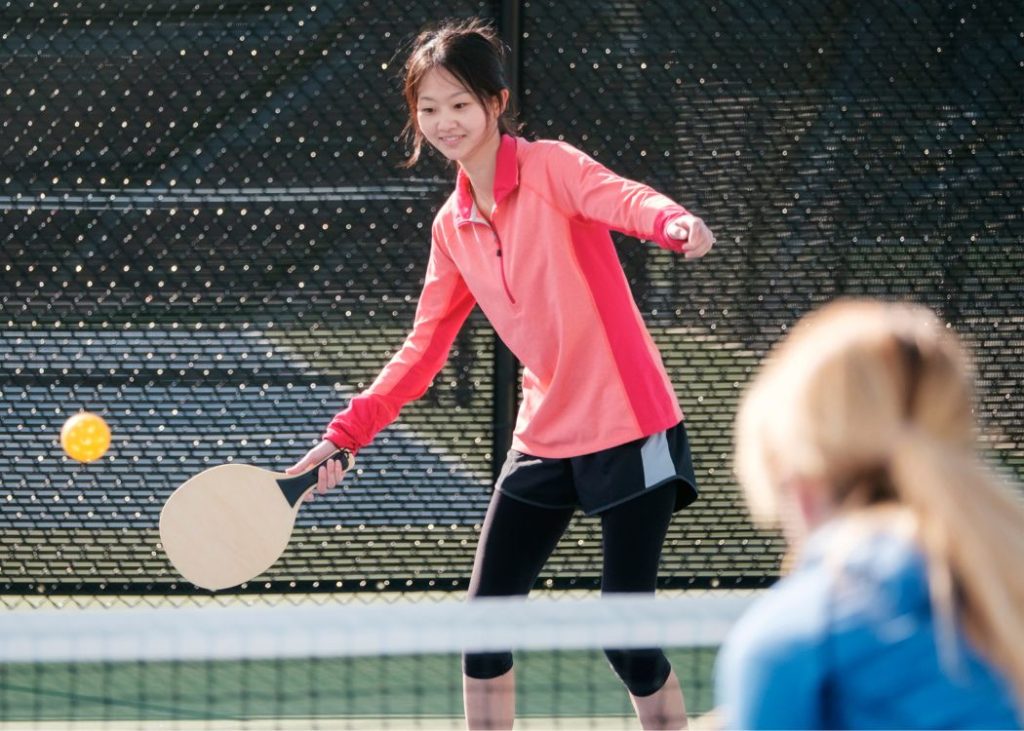
Dinks and Drop Shots
- Dink-to-Dink Drill:
- Players stand at the kitchen line and exchange soft dinks back and forth while focusing on touch and control.
- The goal is to keep the rallies going and develop consistent heights.
- Drop Shot Consistency Practice:
- Players practice executing drop shots from various locations, focusing on placement in the non-volley zone.
- Targeting precision enhances soft shot control that can be crucial in matches.
Overhead Smash Practice
- Overhead Smash Drill:
- One partner feeds high balls for the other to practice executing overhead smashes.
- Emphasize footwork for positioning and proper follow-through for power.
- Targeted Overhead Drill:
- Set targets in the court where you want to land overhead shots, reinforcing accuracy during practice.
- Aiming for specific areas helps develop both power and placement strategies.
Lobbing Techniques
- Aggressive Lob Drill:
- Focus on hitting lobs consistently and accurately while targeting specific areas on the court.
- This develops both the accuracy and height necessary for effective lobbing.
- Game Scenario Lob Drill:
- Simulate game conditions with an opponent at the net while practicing your lobbing.
- Each player should execute lobs against typical network aggressive play to refine technique.
Recovery and Movement Drills
- Quick Recovery Drill:
- After lobbing, practice returning to your original position quickly. This helps establish court coverage post-shot.
- Use agility movements, such as lateral shuffles, to refine recovery techniques.
- Defensive Recovery Drill:
- Partner up for practice where one player executes lobs while the other works on returning to a balanced position effectively.
- This builds necessary agility and helps improve strategic movements during play.
Drill Variations for Competitive Play
- Situational Lob Drill:
- Create mock scenarios where players must respond to their opponents with specific lobbing techniques.
- Focus on varied conditions and improve shot selection agility based on game-like pressure.
- Lob and Attack Drill:
- After executing a lob, immediately look to follow it up with an aggressive shot or volley.
- Reinforce transitional play by merging defensive and offensive techniques.
Incorporating these specialized drills into your training will enhance critical aspects of your pickleball game, contributing to well-rounded skills necessary for competitive play.
Solo Practice Techniques
Practicing alone can be highly effective if you focus on specific techniques that enhance your skills. The following section will detail wall drills, shadow swinging exercises, self-feed methods, utilizing technology for skill enhancement, and tracking progress.
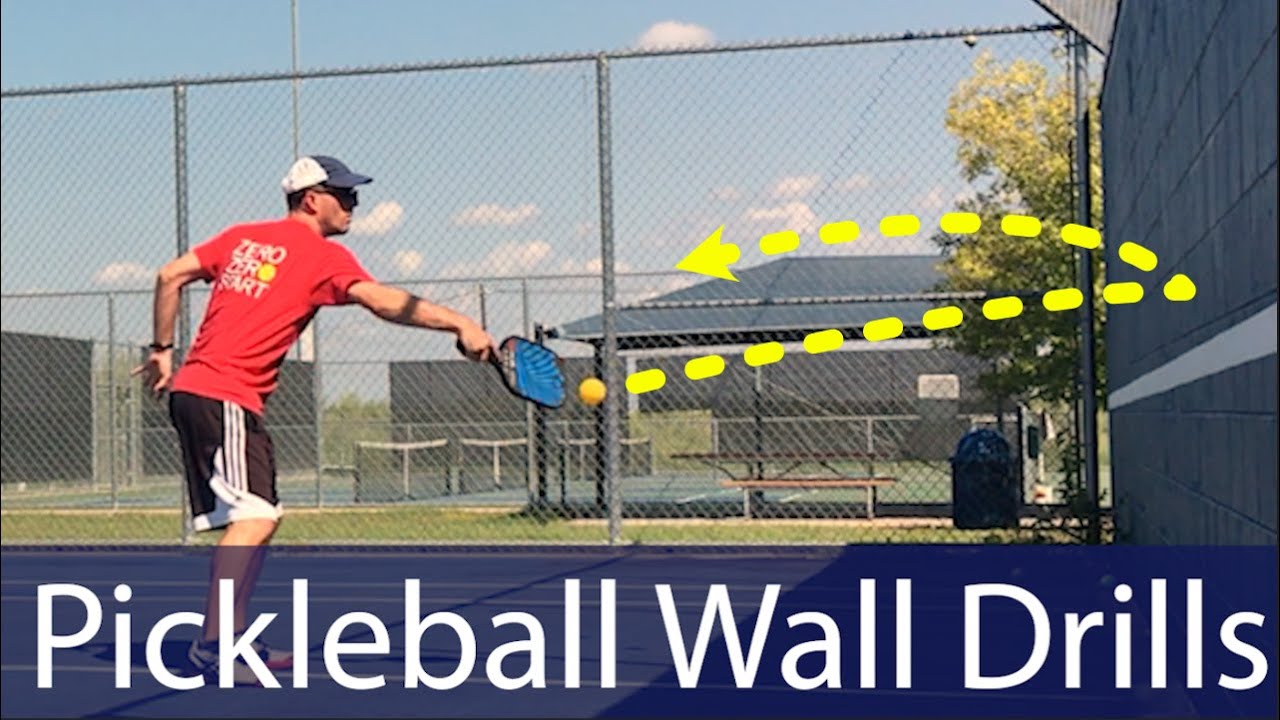
Wall Drills for Consistency
- Targeted Forehand and Backhand Drills:
- Stand at an ideal distance from the wall and hit forehand and backhand strokes, aiming for a specific target area drawn on the wall.
- This helps build accuracy and strengthens overall consistency.
- Dinking and Volleying Wall Practice:
- Set distance limits by standing close to the wall and practicing gentle dinks and volleys.
- Focus on control and maintain low trajectories while engaging with the wall to work on timing and shot precision.
Shadow Swinging Exercises
- Basic Shadow Swings:
- Practice your swings without a ball, ensuring proper stance and technique are in focus. This helps reinforce muscle memory for your shots.
- Regular practice will help improve timing and position during gameplay.
- Integrating Movements:
- While practicing shadow swings, include lateral footwork drills, mimicking your movements while hitting shots.
- This movement integration provides a comprehensive training experience.
Self-Feed and Return Drills
- Self-Tossed Serve Practice:
- Toss the ball in the air and practice your serves consistently. Over time, focus on angles, placement, and increasing the speed of your serve.
- Working on your serve allows you to fine-tune your form while developing muscle memory.
- Self-Feed for Groundstrokes:
- Practice groundstrokes by tossing the ball and returning it against the wall. This solo drill develops consistency and encourages purposeful swings.
Using Technology for Skill Enhancement
- Pickleball Practice Machines:
- Invest in specialized machines that provide ball feeds for practicing a range of shots. This allows players to work on specific drills that simulate matchplay situations.
- Paid variations often come equipped with programmable options for a customized training experience, offering variations based on your preferences.
- Video Recordings:
- Film yourself during practice sessions to analyze your technique, movements, and shot execution. Identify areas for improvement and adjustments needed.
Tracking Progress and Performance
- Progress Journals:
- Maintain a practice journal to document your sessions, including specific drills completed, hours spent practicing each week, and progress assessments.
- This reflection allows you to focus on your achievements and identify areas that require additional work.
- Goal Setting:
- Develop SMART (Specific, Measurable, Achievable, Relevant, Time-bound) goals that clarify the skills you need to develop. Setting manageable milestones assists in maintaining motivation.
Through these solo practice techniques, you can refine your skills, enhance game knowledge, and develop consistency in shot execution. Consistent practice, when executed purposefully, allows players to see tangible improvements in their overall gameplay.
FAQs
How to Practice Pickleball Alone?
Practicing alone can involve utilizing a wall for drills, focusing on self-feeding techniques, utilizing practice machines, and maintaining consistency through volleying, serving, and dinking drills. Focus on targeted practice and maintain a structured routine.
How Do You Hit More Power in Pickleball?
To hit harder, concentration on body mechanics is essential. Engage your legs and core while ensuring proper grip and follow-through for power shots. Consistent practice of these techniques aids in developing strength and power in your shots.
How Do You Dink Better in Pickleball?
To improve your dinking, focus on controlling paddle angles while maintaining a soft touch and low trajectory. Practice with targets to build accuracy, emphasizing partnerships and communication to finely tune touch and precision.
Is Pickleball Really a Workout?
Yes! The sport emphasizes cardio endurance, strength training, flexibility, coordination, and mental sharpness making it an excellent full-body workout that engages both the mind and body.
Conclusion
Pickleball is a dynamic and engaging sport that offers players plenty of opportunities for skill development and enjoyment. Practicing the various pickleball drills outlined in this article will not only enhance your individual skills but also prepare you for competitive play. Whether you are a beginner, intermediate, or advanced player, dedicating time to these drills will foster growth and improvement.
The key to success in pickleball lies in consistent practice, motivated training, and an eagerness to learn. As you incorporate these drills into your routine, be mindful of your progress and stay adaptable to changes in playing conditions or strategies. Embrace the journey of improvement, and enjoy every step of your pickleball development. Happy playing!
